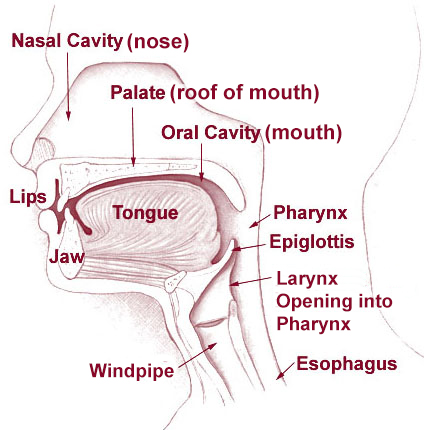 Digestion of food begins in the mouth. |
Recall that the top opening of the digestive tract is the mouth. The first step of the digestive system's "reverse assembly line" also takes place in the mouth. The teeth, tongue, and salivary glands prepare the food to be swallowed, while the tongue, epiglottis, and pharynx conduct food into the esophagus to be led to the stomach.
Let's see what happens to food as it's broken down into smaller parts during digestion. For example, what happens when you eat a chicken sandwich? Click each tab to get a closer look at these structures and their roles in the first part of digestion.
Teeth
Salivary Glands
The Tongue
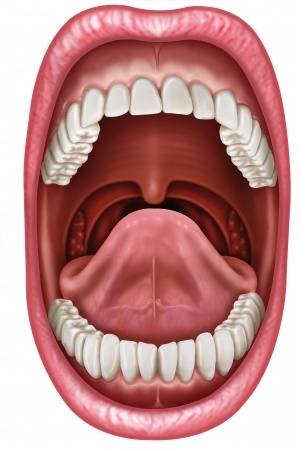 Digestion begins from the very first bite of the sandwich. Teeth in the front of your mouth bite, rip, and tear the food into smaller pieces, while teeth in the back mash and grind the food to make it soft. If you didn't chew the sandwich, it wouldn't be able to get down into your stomach.
Digestion begins from the very first bite of the sandwich. Teeth in the front of your mouth bite, rip, and tear the food into smaller pieces, while teeth in the back mash and grind the food to make it soft. If you didn't chew the sandwich, it wouldn't be able to get down into your stomach.
What kind of digestion is accomplished by the teeth? First, write down or think about the answer to this question. Then click the Show Me button to check your answer.

The teeth help complete mechanical digestion because they physically break down food.
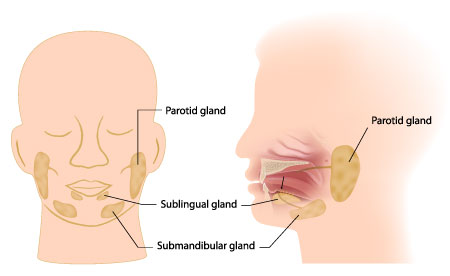
Structures in the face called salivary glands make a slimy liquid called saliva. Saliva has two main jobs. First, it moistens the food, making it soft. Second, it contains a chemical called amylase. Amylase is an enzyme that chemically pulls apart large carbohydrates called starches into their smaller components (which are sugars). Amylase breaks down the carbohydrates in the bread of the chicken sandwich.
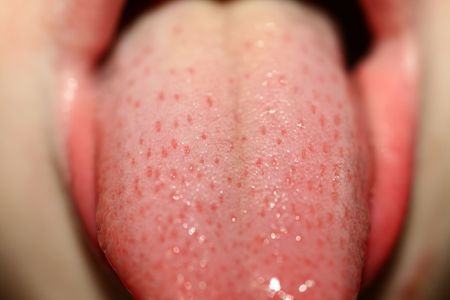 The tongue is a muscular structure that is found in the bottom of the mouth. It has many functions, such as helping you taste the chicken sandwich. However, in digestion, the tongue mostly functions to move food around during chewing and to helping you move food out of your mouth as you swallow.
The tongue is a muscular structure that is found in the bottom of the mouth. It has many functions, such as helping you taste the chicken sandwich. However, in digestion, the tongue mostly functions to move food around during chewing and to helping you move food out of your mouth as you swallow.
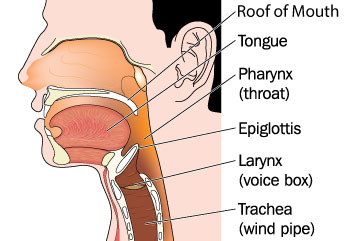 Swallowing requires the coordination of many structures in the mouth and throat. |
Swallowing is the movement of food from your mouth into the next part of the digestive system. It takes the coordination of many different structures.
Once you've chewed the chicken sandwich for a while, it becomes a moist "ball" of saliva and food called a bolus. The tongue forces the bolus toward the back of the throat. As the back of the throat lifts up, the tongue pushes the bolus down the throat. At the same time, a fold of tough tissue called the epiglottis closes over the windpipe so that no food enters the lungs. Once the bolus is past the top of the windpipe, it enters the next part of the digestive system.
The first part of the digestive system's reverse assembly line takes place in the mouth. Test your knowledge of this part of the digestive system. Type in a definition or description of each term.
amylase
teeth
salivary glands
bolus
epiglottis
| Your Responses | Sample Answers |
|---|---|
| Amylase is an enzyme that breaks down carbohydrates. | |
| Teeth are structures that physically tear and mash food. | |
| Salivary glands are structures that make a liquid that contains amylase and moistens food. | |
| The bolus is the lump or ball of food that is swallowed. | |
| The epiglottis is tough tissue that prevents food from entering the lungs. |